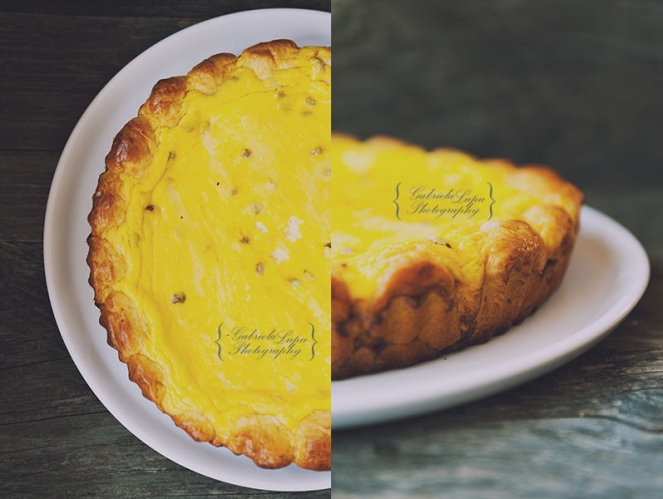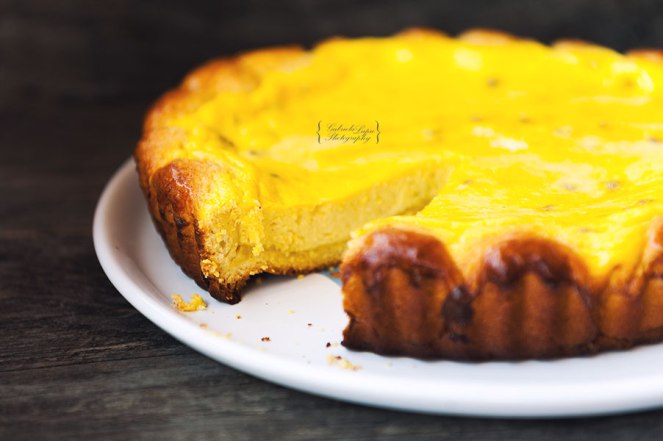
Our Easter Pasca is made on Great Thursday (Thursday before Easter) and is considered the most important bread of the year. It can be simple, with jagged margins, or it can have dough braided edges. Sometimes a cross-shaped braid is placed in the middle, representing the crucifixion of Jesus. You can make this cross out of raisins or cacao powder.
The dough is the same dough that you make for Cozonac. So when you start making desserts for Easter you know the quantity.
The filling is made with fresh cow’s cheese, something like a dry cottage cheese, which is sweetened with sugar and spotted with raisins or sultanas.
Nowadays, you see many other recipes using more filling and a thinner, more easily-prepared base, but a traditional Pasca is more like a stuffed bread than a flan. You can have a chocolate filling or a sour cream filling.
I love Pasca. Since I was a little girl I asked my mom to make it more like a cheesecake than a bread. So less dough and more cheese. She makes an amazing Pasca and I can’t wait to eat it.
For sweet bread dough:
- 250 ml milk
- 500 g white flour
- 150 g sugar
- 3 tsp active dry yeast
- 3 eggs
- ½ tsp salt
- 100 ml oil
- Zest from 1 lemon
- 2 Tablespoon vanilla-rum extract
- 2 pouches vanilla sugar
For filling:
- 600 g cottage cheese
- 5 eggs
- 100 g sour cream
- 100 g raisins
- 200 g sugar
- Zest from 1 lemon
- 3 Tablespoons vanilla-rum extract
- 2 Tablespoon semolina
- 100 g butter (room temperature)
Directions:
In a small bowl, combine the dry yeast with 1 tablespoon of sugar and ¼ of the warm milk. Mix for 1 minute to dissolve the yeast and let it rest for 5-7 minutes.
In a large bowl place the white flour and make a hole in the center. Sprinkle the salt and pour yeast and the milk mixture over flour.
Add the eggs, remaining sugar & milk, lemon zest, vanilla-rum extract and vanilla sugar.
Mix to incorporate all ingredients with a spoon. Add the oil a little at a time and knead with your hands for about 15-30 minutes, until the dough will not stick to your hands. For a good dough the important thing is to knead as hard as you can.
Cover with a clean towel and place in a warm spot. Allow dough to rise until double in size.
For the filling, mix the cream cheese. Add eggs, the sugar, lemon zest, vanilla-rum extract, sour cream and melted butter. Mix thoroughly until all ingredients are combined. Lastly, mix in the semolina and raisins. Let it aside.
Cut the dough into two equal parts, sprinkle some flour on your work surface and roll one part of the dough. Place the sheet in the pan. Put the dough in the pan like for a pie. Add half of the cheese mixture in the middle.
With the second part do the same.
Bake for 45 minutes in the preheat oven.
If you are a raw-vegan person you can make a raw Pasca like this. Enjoy!
Happy Easter!


I’m drooling! In childhood, this was my favorite Easter dessert. Yummy!
Thank you
Happy Easter to you! 🙂
Looks yummy!!
Thank you
Looks perfect for Eastern celebration 👌
Thank you
love this!!!!!
Thank you
You have inspired me. I have a Romanian coming for Easter lunch, maybe I will surprise her by making this!! Thank you!
You are welcome
Looks lovely gonna try today ..Happy Easter to u too
This is a new food for me, which is a rarity! I’ll have to keep my eyes open for it!
This too is new to me. Looking forward to trying the recipe.
Looks really good!
Thank you
This looks delicious, and I LOVE holiday traditions!!
Thank you
I am not a good cook but I deem it fit make a trial. It looks sumptuous. Thank you cookingwithoutlimits.
You are welcome
That looks so good! Reminds me of a Norwegian bread with vanilla custard in the center.
Thank you
You’re welcome!
Oh yum!
Love your Easter treat, rustic festive baking is the best. In Germany, we eat a traditional yeast wreath decorated with chocolate or hard boiled eggs. Happy Easter days!
I like the sound of that!
That looks pretty good. I like the flavor combinations, too.
I have a sneaking suspicion that the cheese they probably use is a type of farmer’s cheese instead of cottage cheese. My husband is from Czech Republic and they don’t even have cottage cheese there, as we know it. They use this farmer’s cheese. My grocery stores sell it in the dairy section, usually near the sour cream and cream cheeses. There is a soft and somewhat hard kind. We only find the somewhat hard kind in the local Polish store. That is used for various sweet dumpling doughs and to fill pastries with, usually flavored with lemon zest and/or rum like the pastry you mention above. Farmer cheese is less liquidy than American-style cottage cheese.
I’d love to make it, but my hubby is usually against anything Romanian. My first love was a Romanian man. I enjoyed his mother’s cooking. She had some Greek background so they celebrated the Orthodox Easter, which is on a different day.
You are right about the cheese. Cottage cheese is the closest cheese to the one we use.
I’m tempted to make this for Easter … maybe just a few tart sized ones instead of a large pasca though. And I can make some fresh cheese to fill it with.
Happy Easter!
I like the look; it looks yummy.
Thank you
Wow, that looks so yummy!!
Thank you
Love this although I never heard of Pasca. Great storyline leading up to your recipe. Looks really yummy and thanks for the introduction to this customary dish! 🙂
Thank you
Love to share this recipe on my blog!
Please share!
Will do and love your photo’s
Thank you
Done thanks 🙂
https://tommytraveler.com/cookingwithoutlimits/
Very interesting and it looks devine.
Thank you
May I share this recipe on our blog? https://favouritefoodfromeucountries.wordpress.com/
Please share!
Thank you!
Happy Easter, bread is something I have been wanting to get to tackle for while now, so I think this will be something to add to the list of things to try later in the year when my copy of modernist bread arrives
Reblogged this on Favourite Food from EU Countries and commented:
Just in time for Easter, here is a recipe for Pasca, a traditionan Romanian sweet bread. Thank you to Gabi from Cooking Without Limits. Check out her blog, and Happy Easter!
Thank you. Happy Easter!
Oh yum, this looks so good, kind of a cross between a cheesecake and danish? -Kat
Thank you
Looks Yummy. Happy Easter.
this looks great! happy easter 🙂
Thank you
That’s a beautiful colour and looks delectable too! Happy Easter!
Thank you
Thank you for reminding me of my Romanian heritage with this post and inspiring me to bake a pasca for the first time. I went with the more traditional version with braided dough around the edge as the miniature pasca I had envisioned seemed problematic. I used lemon zest in the dough (next time I’ll add some to the filling as well) for a subtle flavour and made my own dry curd cheese, an acid curdled milk (paneer). The result was very pleasing though I’d like to increase the amount of filling used to something more like the one in this post.
Looks great!
This looks amazing!
Thank you
Your pictures look amazing from the last time I visited your blog!
Thank you
This looks awesome! Your instructions made it easy enough that I think I could attempt this myself. Thanks for a great post!
Thank you
This sounds and looks amazing! I’m gonna have to make myself one!
Thanks for sharing!
Thank you